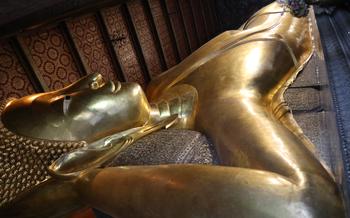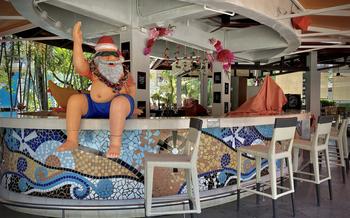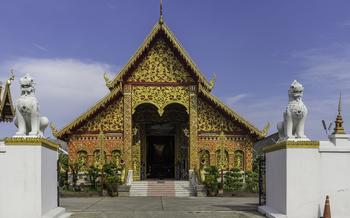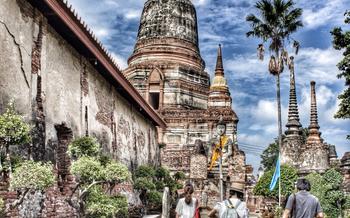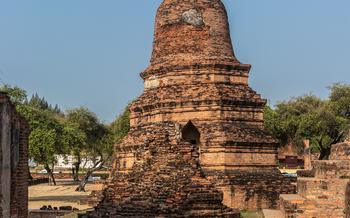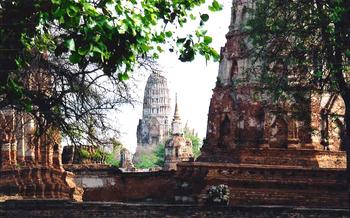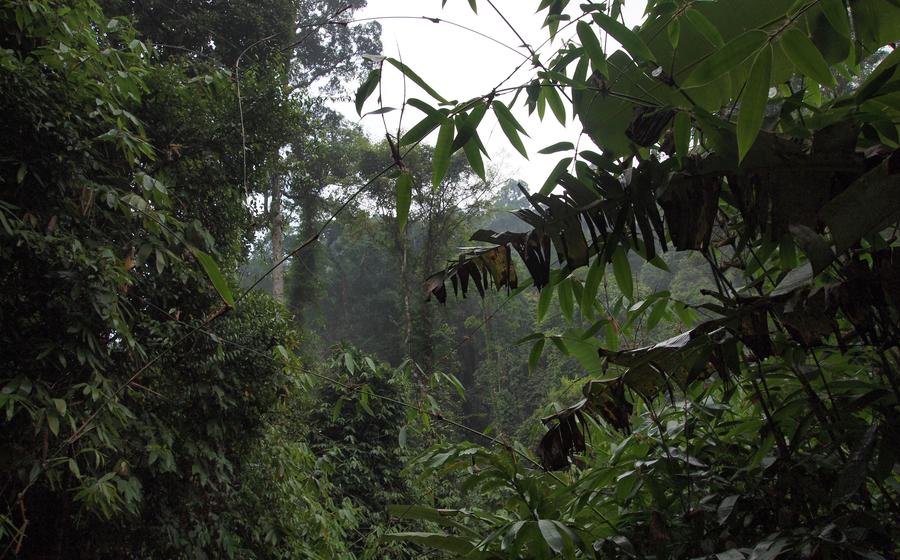
Wat Bang Riang Temple
- The Wat Bang Riang Temple: A Stunning Historical Gem
- Exploring the Temple Grounds: A Journey Through Serenity
- The Grand Buddha Image: A Symbol of Reverence
- The Ordination Hall: A Center of Spiritual Growth
- The Ubosot: Where Sacred Rituals Unfold
- The Bell Tower: A Symbol of Time and Mindfulness
- The Chedi: A Monument of Spiritual Aspiration
- The Sala: A Place of Rest and Reflection
- The Mondop: A Repository of Sacred Scriptures
- The Viharn: A Multipurpose Assembly Hall
- The Surrounding Area: A Tapestry of Natural Beauty
- Practical Information for Visitors: Ensuring a Smooth Experience
- Insider Tip: Unveiling Hidden Treasures
The Wat Bang Riang Temple: A Stunning Historical Gem
Nestled in the heart of Khao Lak, Thailand, the Wat Bang Riang Temple stands as a testament to the country's rich cultural heritage and spiritual traditions. Steeped in history and significance, the temple attracts countless visitors seeking tranquility, enlightenment, and a glimpse into the essence of Thai Buddhism.
The temple's origins date back to the late 18th century, founded by a revered monk named Luang Pu Thuat, who is highly revered throughout Thailand for his spiritual teachings and miraculous powers. Over the years, Wat Bang Riang has undergone several renovations and expansions, each adding to its architectural splendor and religious importance.
The temple complex comprises a stunning array of structures, each serving a unique purpose in the Buddhist faith. Visitors are awed by the intricate carvings, vibrant murals, and towering stupas that adorn the temple grounds, creating a truly enchanting atmosphere. As a sacred site, Wat Bang Riang exudes a profound sense of serenity and spirituality, inviting visitors to embark on a journey of inner peace and self-discovery.
Exploring the Temple Grounds: A Journey Through Serenity
As you step through the gates of Wat Bang Riang, a sense of peace and tranquility envelops you. The temple grounds are meticulously landscaped, with lush greenery, blooming flowers, and serene water features creating a harmonious atmosphere. The layout of the complex is designed to promote a sense of spiritual exploration and reflection, with each structure and landmark carefully positioned to enhance the visitor's experience.
Notable structures within the grounds include the ordination hall, the ubosot, the bell tower, the chedi, the sala, the mondop, and the viharn. Each of these buildings serves a specific purpose in Buddhist religious practices and contributes to the overall spiritual significance of the temple. The peaceful ambiance and sacred energy that permeate the temple grounds make it an ideal place for meditation, reflection, and connecting with your inner self.
The Grand Buddha Image: A Symbol of Reverence
At the heart of Wat Bang Riang Temple lies a majestic Buddha statue, radiating an aura of serenity and reverence. Towering over the temple grounds, this colossal figure exudes an aura of spirituality that draws pilgrims and visitors alike. Its size and grandeur are awe-inspiring, evoking a sense of devotion and respect. The statue's intricate features and serene expression reflect the essence of Buddha's teachings, inviting contemplation and introspection.
The Grand Buddha Image is not just a work of art but also a symbol of religious devotion and cultural heritage. For the local community, it represents a focal point of worship and a source of spiritual guidance. Offerings of flowers, incense, and candles are placed at its base, accompanied by prayers and chants that fill the air with a sense of piety. The statue serves as a reminder of Buddha's teachings, emphasizing the principles of compassion, wisdom, and enlightenment.
The story behind the creation of the Grand Buddha Image adds to its significance. According to local legend, the statue was commissioned by a wealthy merchant who sought to honor his deceased father. The merchant spared no expense in creating this magnificent tribute, and the result was a masterpiece that has stood the test of time. The statue's enduring presence serves as a testament to the merchant's devotion and the enduring legacy of Buddhism in Thailand.
The Ordination Hall: A Center of Spiritual Growth
The ordination hall, also known as the sim, is a central building within the Wat Bang Riang Temple complex. It serves as a sacred space for the ordination of Buddhist monks and novices, a rite of passage that marks their formal entry into the monastic order. The ordination hall is typically the largest and most elaborate structure in the temple, reflecting its significance in the Buddhist tradition.
The ordination hall at Wat Bang Riang is a beautiful example of traditional Thai architecture. It features a steeply pitched, multi-tiered roof adorned with intricate carvings and colorful tiles. The walls are decorated with vibrant murals depicting scenes from the life of Buddha and other important Buddhist stories. The interior of the hall is spacious and airy, with a central altar where the ordination ceremonies take place.
During an ordination ceremony, the candidates for monkhood or novicehood are led into the ordination hall in a solemn procession. They prostrate themselves before the abbot and other senior monks, who chant prayers and administer the vows of the monastic life. The candidates then change into their saffron robes, symbolizing their renunciation of worldly possessions and their commitment to the path of spiritual enlightenment.
The ordination hall is not only a place for ordinations but also a center of spiritual growth and learning for monks and novices. They gather here for daily meditation sessions, chanting of scriptures, and teachings from their preceptors. The ordination hall is a reminder of the importance of discipline, humility, and devotion in the pursuit of spiritual liberation.
The Ubosot: Where Sacred Rituals Unfold
At the heart of the Wat Bang Riang Temple complex stands the ubosot, a sacred and revered structure that serves as the primary venue for religious ceremonies and rituals in Thai Buddhism. This grand hall is a testament to the deep faith and devotion of the local community.
The ubosot's architectural features are a blend of traditional Thai design and symbolic elements that hold deep religious significance. Its high, sweeping roof represents the heavens, while the intricate carvings and decorations symbolize the Buddha's teachings and the path to enlightenment.
Inside the ubosot, an atmosphere of serenity and spirituality prevails. The walls are adorned with vibrant murals depicting scenes from the Buddha's life and teachings, creating a visually captivating and inspiring space.
The central feature of the ubosot is the Buddha image, positioned prominently on a raised platform. This sacred statue is the focal point of worship and devotion for both monks and laypeople alike.
Throughout the day, the ubosot becomes a hive of activity as monks and laypeople gather for various religious ceremonies and rituals. These include daily chanting sessions, meditation practices, and special ceremonies such as ordinations, weddings, and funerals.
The ubosot is not only a place of worship but also a center of community life. Here, the local community comes together to celebrate religious festivals, share stories, and strengthen their bonds.
Whether you are a devout Buddhist or simply a curious traveler seeking to understand the essence of Thai culture, the ubosot at Wat Bang Riang Temple is a must-visit destination. Its sacred atmosphere and the opportunity to witness religious rituals firsthand offer a profound and enriching experience.
The Bell Tower: A Symbol of Time and Mindfulness
The bell tower, a prominent feature in Thai temples, holds a profound significance in Buddhist practices. Constructed using traditional techniques, these towers often showcase intricate designs and carvings that reflect the temple's architectural style. The bell, suspended within the tower, plays a crucial role in Buddhist rituals and ceremonies. Its melodious sound reverberates through the temple grounds, serving as a reminder of the fleeting nature of time and the importance of mindfulness. The ringing of the bell invites devotees to pause, reflect, and connect with their spiritual selves. It also marks the beginning and end of meditation sessions, guiding practitioners into a state of deep contemplation. The bell's presence serves as a constant reminder to be mindful of the present moment and to let go of worldly distractions.
The Chedi: A Monument of Spiritual Aspiration
In Thai Buddhism, the chedi, also known as a stupa, holds immense spiritual significance. These towering structures, often referred to as "pagodas" in the West, serve as monuments to the Buddha's teachings and represent the path to enlightenment. Constructed in various architectural styles, chedis can be found throughout Thailand, each embodying unique symbolic meanings.
At the Wat Bang Riang Temple, the chedi stands as a majestic symbol of spiritual aspiration. Its intricate design and towering presence evoke a sense of awe and reverence among visitors. The chedi's architectural features, such as the bell-shaped dome, the elongated spire, and the decorative elements, all hold symbolic meanings related to the Buddhist cosmology and the journey towards Nirvana.
Beyond its architectural significance, the chedi is believed to contain sacred relics or representations of the Buddha, further enhancing its spiritual importance. These relics, often consisting of fragments of bone or personal belongings of the Buddha, are considered to possess immense power and blessings. Devotees often make offerings and perform rituals at the chedi, seeking merit and protection through their connection with the Buddha's teachings.
The chedi at Wat Bang Riang Temple also plays a significant role in funerary practices. In Thai culture, it is customary to cremate the deceased and place their ashes within a chedi. This practice symbolizes the impermanence of life and the liberation of the soul from the cycle of rebirth. The chedi serves as a memorial to the departed, allowing their loved ones to pay respects and seek solace through prayer and meditation.
The Sala: A Place of Rest and Reflection
Amidst the tranquil grounds of Wat Bang Riang, you'll find the sala, an integral part of Thai temple architecture. These open-sided pavilions serve as serene sanctuaries for meditation, quiet contemplation, and communal gatherings. Constructed from natural materials like wood or bamboo, salas seamlessly blend with the surrounding landscape, exuding an aura of peace and harmony.
As you step into the sala, you'll notice its simple yet elegant design. The open structure allows for a gentle breeze to flow through, creating a refreshing and airy ambiance. The elevated platform provides a panoramic view of the temple grounds, inviting you to immerse yourself in the tranquility of your surroundings.
The sala serves as a multi-purpose space, accommodating various activities. Devotees often seek solace within its walls, finding respite from the bustling world outside. Here, they can meditate in silence, chant mantras, or simply sit in quiet contemplation, connecting with their inner selves and seeking spiritual guidance.
The sala also plays a vital role in community life, hosting gatherings, ceremonies, and religious teachings. During temple fairs and festivals, the sala transforms into a vibrant hub of activity, where locals come together to celebrate their shared faith and traditions.
Whether you seek a moment of tranquility or a space for communal connection, the sala at Wat Bang Riang offers a sanctuary for the soul. Take a break from your temple exploration, find a comfortable spot on the bamboo mats, and let the serenity of the surroundings wash over you.
The Mondop: A Repository of Sacred Scriptures
Within the sacred grounds of Wat Bang Riang, one discovers the mondop, a revered structure dedicated to preserving and studying Buddhist scriptures. Its architectural design mirrors the grandeur of its purpose, featuring intricate carvings and symbolic elements that pay homage to the teachings of the Buddha.
The Viharn: A Multipurpose Assembly Hall
The viharn, also known as the assembly hall, is a prominent structure within the Wat Bang Riang Temple complex. It serves as a multipurpose space for religious ceremonies, gatherings, and teachings. The viharn's architectural features are a testament to its significance and functionality.
The viharn typically features a rectangular shape with a gabled roof supported by pillars. The roof is often decorated with intricate carvings and colorful tiles, adding to the overall grandeur of the structure. The interior of the viharn is spacious and airy, providing ample room for worshippers to gather for various religious activities.
The viharn is a central hub for the temple community. It hosts regular ceremonies, including daily prayers, chanting sessions, and special events such as festivals and ordination ceremonies. During these ceremonies, monks and laypeople gather in the viharn to offer prayers, listen to teachings, and participate in rituals.
In addition to religious ceremonies, the viharn also serves as a venue for community gatherings and educational programs. Monks and community leaders often use the space to conduct classes, workshops, and discussions on various topics related to Buddhism, culture, and local traditions. The viharn provides a welcoming and inclusive environment for people to come together, learn, and share their knowledge.
The viharn at Wat Bang Riang Temple is a testament to the temple's commitment to providing a sacred space for religious practices, community engagement, and spiritual growth. Its multipurpose functionality reflects the diverse roles that temples play in Thai society, serving as centers of worship, education, and cultural preservation.
The Surrounding Area: A Tapestry of Natural Beauty
Beyond the spiritual allure of Wat Bang Riang, the surrounding area unveils a captivating tapestry of natural wonders. Embark on a hiking adventure through lush forests, where the symphony of birdsong accompanies your every step. Discover hidden waterfalls cascading down rocky cliffs, their refreshing mist enveloping you in tranquility. Explore the nearby beaches, where pristine sands meet crystal-clear waters, inviting you to bask in the sun's golden embrace. Venture out to the neighboring islands, where vibrant coral reefs and diverse marine life await your exploration. In this harmonious coexistence of nature and spirituality, you'll find a profound connection to the divine and the wonders of the natural world.
Practical Information for Visitors: Ensuring a Smooth Experience
Location and Transportation: Wat Bang Riang is situated in the heart of Khao Lak, making it easily accessible by both public and private transportation. Tuk-tuks, taxis, and songthaews (local buses) are readily available, offering a convenient and affordable way to reach the temple. For those arriving by car, ample parking space is provided within the temple grounds.
Dress Code and Etiquette: When visiting a Buddhist temple, it is essential to dress respectfully. Avoid wearing revealing or overly casual clothing, and opt for modest attire that covers your shoulders and knees. Shoes should be removed before entering the temple's main buildings, and it is customary to walk barefoot or in socks.
Hours of Operation and Admission Fees: Wat Bang Riang welcomes visitors daily from 8 AM to 5 PM. Admission to the temple is free of charge, allowing everyone to experience its spiritual and historical significance without financial barriers.
Photography and Respect: While photography is generally permitted within the temple grounds, it is crucial to be mindful of the sacred nature of the site. Avoid taking photos during religious ceremonies or when monks are engaged in meditation. Always ask permission before photographing people, and be respectful of their privacy.
Guided Tours: For a more in-depth understanding of the temple's history and significance, consider booking a guided tour. Knowledgeable guides can provide insights into the temple's architecture, rituals, and spiritual practices, enriching your visit.
Tips for a Meaningful Experience: To fully immerse yourself in the temple's serene atmosphere, arrive early in the morning or late in the afternoon to avoid crowds. Take your time exploring the grounds, allowing yourself to soak in the tranquility and beauty of the surroundings. Engage with the local community by observing their rituals and customs, and don't hesitate to ask questions to deepen your understanding of Thai Buddhism.
Insider Tip: Unveiling Hidden Treasures
Beyond the main attractions, Wat Bang Riang holds hidden gems waiting to be discovered by curious travelers. Venture off the beaten path and uncover a secluded meditation garden nestled amidst lush greenery, where you can find tranquility and inner peace. Learn about the ancient art of Thai massage at the temple's massage school, where experienced practitioners offer soothing treatments that will rejuvenate your body and soul.
Engage with the local monks and ask about their daily lives, their spiritual practices, and the history of the temple. They are often delighted to share their knowledge and insights, providing a deeper understanding of Thai Buddhism and the significance of Wat Bang Riang.
Explore the surrounding area and discover hidden waterfalls, pristine beaches, and picturesque viewpoints that offer breathtaking panoramas of the region. Take a guided tour to learn about the local flora and fauna, or embark on a trekking adventure through the lush jungle trails, where you'll encounter exotic wildlife and stunning natural landscapes.
To fully immerse yourself in the temple's spiritual atmosphere, consider visiting during a religious ceremony or festival. These events offer a glimpse into the vibrant traditions of Thai Buddhism and provide a unique opportunity to witness the devotion and reverence of the local community.


